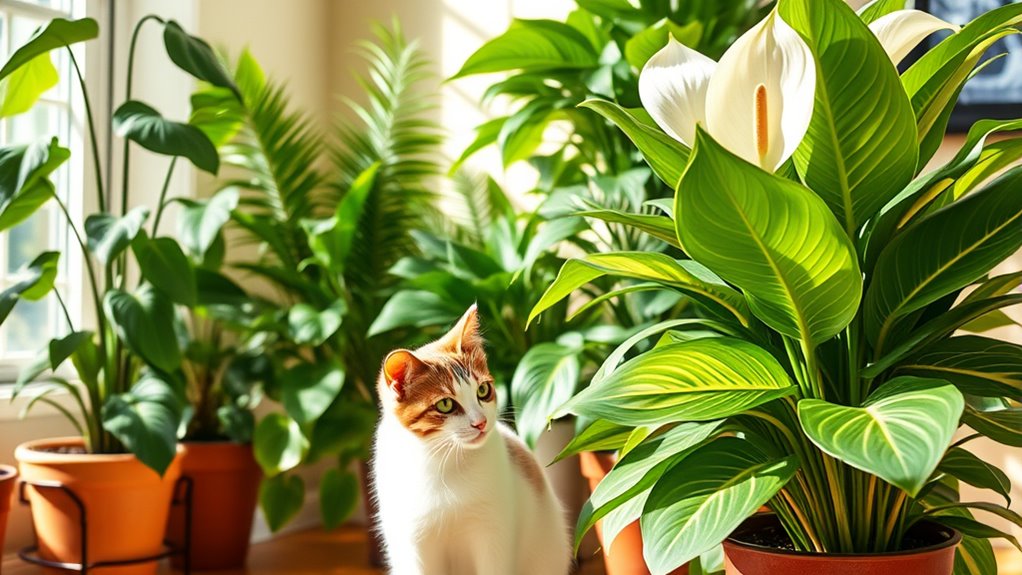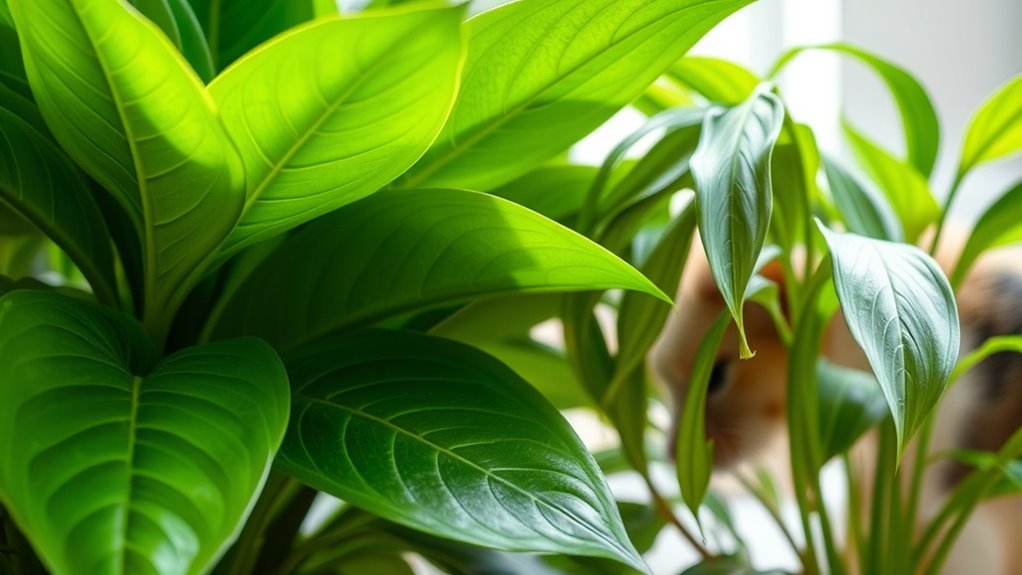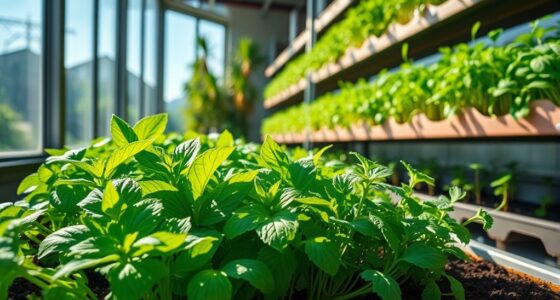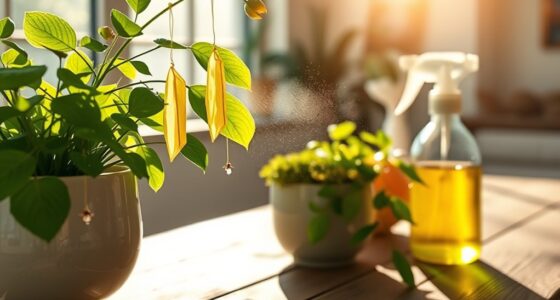Many popular houseplants can pose hidden risks to your pets and family. While some, like Boston ferns or succulents, are safe and add beauty, others such as pothos or lilies contain toxins that can cause mouth irritation, vomiting, or more serious health issues. It’s important to identify which plants are safe and keep toxic ones out of reach. Keep exploring to learn how to select the best, pet-friendly plants for your home.
Key Takeaways
- Many common houseplants like pothos and lilies are toxic and can cause serious health issues in pets and children.
- Pet-safe plants such as spider plants and Boston ferns pose minimal risk and are a safer choice for homes with curious pets.
- Understanding the toxicity levels of houseplants helps prevent accidental ingestion and reduces health risks.
- Keeping toxic plants out of reach and choosing non-toxic varieties enhances indoor safety and peace of mind.
- Researching and properly identifying houseplants is essential to avoid hidden risks and maintain a healthy, pet-friendly environment.

Have you ever wondered whether your houseplants are safe for your family and pets? It’s a common concern, especially when you love decorating with greenery but worry about potential dangers lurking in your home. Many popular houseplants are beautiful and easy to care for, but some contain toxins that can cause serious health issues if ingested. Knowing which plants are pet-safe and which aren’t can save you a lot of stress and prevent accidental poisonings.
Pet-safe plants are generally non-toxic and pose minimal risk if your furry friends decide to nibble on them. These plants can bring color and life to your home without the fear of harming your pets. For example, plants like Boston ferns, spider plants, and certain succulents, such as haworthia, are known for being safe choices. They’re not only visually appealing but also give you peace of mind. If your pet is curious and tends to chew on houseplants, these options are a smart way to decorate without risking their health.
On the other hand, some popular plants can be quite dangerous. Plants like pothos, philodendrons, and lilies are common in many homes, but they contain compounds that can cause a wide range of symptoms if ingested. These symptoms include mouth irritation, vomiting, diarrhea, difficulty swallowing, and even more severe issues like organ failure in extreme cases. If you have children or pets that tend to explore or chew on everything, it’s essential to avoid these toxic options. Even small amounts can cause a significant reaction, so it’s better to be safe than sorry.
It’s tempting to fill your space with lush, vibrant plants, but the risks are real. Always research each plant before bringing it into your home, especially if you share your space with animals or small children. Many reputable resources list houseplants by their safety rating, making it easier to select non-toxic options. If you already own potentially toxic plants, consider placing them out of reach or in rooms that your pets can’t access. Additionally, understanding the toxicity levels of popular houseplants can help you make more informed decisions.
Being aware of the hidden risks in popular houseplants is vital for a safe and happy home. By choosing pet-safe varieties and keeping toxic plants away from curious paws and mouths, you can enjoy the beauty of indoor greenery without compromising safety. It’s a simple step that can make all the difference in protecting your loved ones and maintaining a peaceful, plant-filled space.
Frequently Asked Questions
Are There Natural Remedies for Poisoning From Houseplants?
Yes, there are natural remedies if you suspect houseplant poisoning. You should immediately rinse your mouth with water if you’ve ingested something harmful, then give yourself activated charcoal to absorb toxins. Drinking plenty of water helps flush out poisons, and you can try honey or milk to soothe irritation. However, it’s vital to contact a healthcare professional or poison control for personalized advice and urgent care.
How Can I Tell if My Pet Has Ingested a Toxic Plant?
If your pet ingests a toxic plant, you’ll notice sudden symptoms like vomiting, drooling, diarrhea, or difficulty breathing—warning signs flashing like neon lights. You might see your pet pawing at their mouth or acting unusually lethargic. Act quickly: call your vet immediately. Keep a photo of the plant handy for identification. The quicker you respond, the better your chances of preventing serious harm.
Do All Houseplants Contain Hidden Toxins?
Not all houseplants contain hidden toxins, but many do, so it’s important to research each plant you bring home. Some plants are safe, while others can cause health issues if ingested or even touched. Always check reputable sources or consult with a veterinarian before introducing new plants into your home. Keeping plants out of your pet’s reach is the best way to prevent accidental poisoning.
Are There Any Benefits to Keeping Toxic Plants Around Pets?
There are no benefits to keeping toxic plants around pets. The risks far outweigh any potential aesthetic or air-purifying advantages. Toxic plants can cause illness or even be fatal if ingested by your furry friends. Instead, focus on pet-safe plants that beautify your home without endangering their health. Your pets rely on you to keep their environment safe, so choose non-toxic options whenever possible.
How Often Should I Check My Plants for Potential Hazards?
Like a vigilant guardian, you should check your plants weekly for hazards. Regular inspections let you spot signs of toxicity, pests, or damage early—think of it as your own version of Pandora’s box, but with safety instead of surprises. Carefully examine leaves, stems, and soil, and keep a list of pet-safe options handy. This routine helps prevent accidental poisoning and keeps your furry friends happy and healthy.
Conclusion
Now that you know which houseplants are safe and which are toxic, you can protect your furry friends like a knight guarding treasure. Think of your home as a delicate garden, where every pet’s safety is the shining jewel. With a little research and care, you’ll create a lush, pet-friendly paradise that’s as safe as a cozy fortress. After all, a happy pet makes your house truly feel like home.










